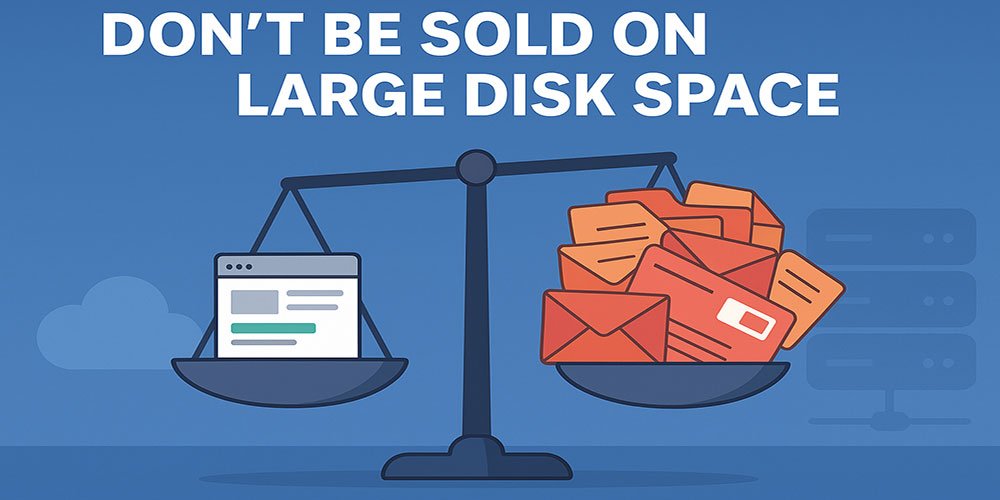Don’t Be Sold on Large Disk Space: The Email Hosting Myth That’s Costing You Money
In the web hosting world, “large disk space” gets thrown around like a magic wand. It’s pitched as the golden ticket to a better website and more reliable email. But here’s the truth: for most small businesses, large disk space has almost nothing to do with your website performance — and everything to do with how your emails are stored.
Most websites are lean by design, usually sitting well under 1GB. It’s your email, not your website, that eats up space over time. And if you don’t understand how your email is stored, you’re more likely to keep upgrading hosting unnecessarily.
The Real Disk Space Culprit: Email, Not Your Website
Website content is typically lightweight and carefully optimized to keep loading speeds fast. That’s because search engines reward speed and visitors punish slow sites. So, a properly managed website doesn’t need 10GB or 20GB of space.
Email, on the other hand, quietly stacks up. Attachments, old threads, and inbox clutter live on your hosting server. If you’re using IMAP, all your messages stay stored on that server indefinitely unless you manually archive or delete them. That’s why many businesses find themselves upgrading hosting plans just to keep their inbox alive.
How IMAP Creates the Illusion of “Safety”
IMAP (Internet Message Access Protocol) is often sold as a “secure” option because your emails remain on the server. So if your laptop crashes, your mail can still be accessed from another device. That’s technically true — but it’s only part of the story.
- IMAP doesn’t replace proper backups. If your hosting account hits its quota or gets compromised, you’re still at risk.
- Over time, IMAP mailboxes grow to tens of gigabytes, forcing you to pay for more hosting space.
- Most businesses with just one or two mailboxes don’t need this level of storage on the server.
For long-term storage, relying on IMAP alone is like using your inbox as a warehouse. It works — until it doesn’t.
POP vs IMAP vs Exchange: What You Really Need
Here’s the reality: not everyone needs IMAP. And not everyone should be sold on “more space” as the answer.
- POP (Post Office Protocol)
POP downloads your email directly to your device and clears it from the server. This keeps your hosting lean and costs low. If you have just one device accessing your email and you keep good backups of your computer, POP is the smarter, cheaper option.
- Best for: Small businesses with one or two mailboxes.
- Pro: Keeps hosting costs low.
- Con: Not ideal for syncing across multiple devices.
- IMAP (Internet Message Access Protocol)
IMAP keeps emails stored on the server and syncs them across devices. If you use your laptop, phone, and tablet to check mail, IMAP gives you flexibility. But this convenience comes at a cost — increased storage usage and higher hosting bills over time.
- Best for: Users who want the same mailbox on multiple devices.
- Pro: Easy access anywhere.
- Con: Mailbox size keeps growing unless you archive.
- Exchange or Google Workspace (G Suite)
If you’re a larger company with multiple mailboxes and a real need for substantial email storage, cloud-based platforms like Microsoft Exchange or Google Workspace are built for that. They’re designed to handle big mailboxes, advanced security, and better syncing without affecting your website hosting space.
- Best for: Corporates and teams with high storage needs.
- Pro: Scalable, secure, and separated from your web hosting.
- Con: Higher monthly cost, but it’s fit for purpose.
Why Backups Still Matter
Many businesses lean on IMAP because they think it’s their “backup.” It’s not. If your hosting account gets suspended, hacked, or hits its limit, your emails can be gone or inaccessible in seconds.
A proper backup strategy involves archiving your email to an external hard drive or cloud backup. This not only frees up hosting space but gives you control over your data.
How Hosting Companies Sell the Myth
A lot of hosting companies highlight large disk space in their plans to make them look like better value. The catch? Most of that space ends up being used by your inbox — not your website. It’s a subtle upsell that often goes unnoticed until your plan starts creeping up in cost.
The smarter approach is to choose the right email protocol for your actual needs, not the one that looks good on a sales page.
The Smart Move for Small Businesses
If your business runs one or two mailboxes and you don’t need multi-device access, go POP. It’s simpler, cheaper, and cleaner.
If you need multiple devices, use IMAP but archive regularly to avoid paying for ever-growing hosting space.
If you’re a larger business, invest in Microsoft Exchange or Google Workspace and keep your website hosting separate.
This approach keeps your website fast, your email costs predictable, and your data properly backed up.
Bottom line: Large disk space isn’t a necessity for most businesses. It’s a sales tactic. What matters more is using the right email solution for your setup. Your website doesn’t need 20GB of hosting space. Your inbox does — but only if you let it.
Smart hosting is about strategy, not size.





